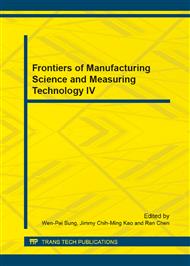[1]
Building Industry standard of the People's Republic of China, Technical code for testing of building foundation piles, JGJ 106-(2003).
Google Scholar
[2]
Chen Lun, Jiang Li, Wang Haiyan. Field full-scale test study on tension bearing mechanism of dx piles cast-in-situ [J]. Industrial Construction, 2004, 34(10): 33-35.
Google Scholar
[3]
Chen Fan. Pile quality detection technology [M]. Beijing: China Architecture & Building Press, (2003).
Google Scholar
[4]
Wang Weiya. Study on transmission principle of unlift load for drill filling piles [J]. Journal of Hefei University of technology (natural science), 1998,21(4):71~77.
Google Scholar
[5]
Zhang Shanggen. Analysis of deformation on tension piles [J]. Industrial Construction, 2002, 32(11): 40-41.
Google Scholar
[6]
He Min. Bored pile construction quality defects and processing methods [J]. Fujian Building Materials, 2008 (2): 84-85.
Google Scholar
[7]
Zhang Mingyi, Liu Junwei. Time-effect of uplift bearing capacity of drilled grouting pile in ground of sandy soil and weathered sandrock [J] . Rock and Soil Mechanics, 2008, 29(11): 3153-3156.
Google Scholar
[8]
Tang Jian. Application of Optical Fiber Sensing Technology to Stress Test of Bored Pile [J]. Building Construction.
Google Scholar
[9]
Yu Xiaokui. Research on the Testing of Piles Based on Distributed Optical Fiber Monitoring Sensing Technique [J]. Electric Power Survey & Design, 2007 (6): 12-16.
Google Scholar
[10]
Li Chuan, Zhang Yimo, Zhao Yonggui. Fiber Bragg grating principle, technology and sensing applications[M]. Beijing: Science Press, (2005).
Google Scholar
[11]
Chai Jing, Qiu Biao, Li Yi, Zhu Lei. Simulation Experiment of Embedded Fiber Bragg Grating Monitoring in Rock Deformation through Borehole [J]. Journal of Mining & Safety Engineering, (2012).
Google Scholar
[12]
Piao Chunde, Shi Bin, Wei Guangqing, Zhu Youqun, Zhang Dan. Application of distributed fiber optic sensing techniques in bored pile detection [J]. Chinese Journal of Geotechnical Engineering, 2008, 30(7).
Google Scholar
[13]
Li Chuan, Li Xin, Zhang Daxun, Wu Sheng, Li Yingna, Li Jun. Fiber Bragg grating strain sensors for reinforced concrete girders [J]. Opto-electronic Engineering, 2004, 8: 009.
Google Scholar
[14]
Li Chuan, Li Xin, Sun Yu. Research of fiber Bragg grating sensors in dead load test of RC girder [J]. China Civil Engineering Journal, 2005, 38(2): 64-67.
Google Scholar
[15]
Li Tianxing, Li Chuan, Meng Lei. The Sensing Principle and Structure of Fiber Bragg Grating Sensor [J]. Infrared Technology, 32(7): 392-394.
Google Scholar


